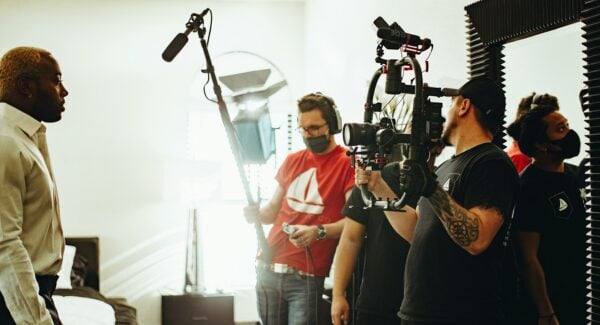Lessons from filmmaker Bobby Mardis on Maximizing Resources, Building Trust, and Finishing Strong
By Carole Dean
There’s a certain kind of magic that happens when a filmmaker shows up with a problem and a pocketful of scrappy solutions. It’s the alchemy of turning scarcity into resourcefulness, limits into creativity, and constraints into invention.

At a recent Learn Producing Course class titled “Guerrilla Filmmaking,” Bobby Mardis — one of Hollywood’s most creative and well-loved producers — walked us through exactly how he does that. He described, with the blunt honesty and wry humor of someone who’s been in the trenches, the nuts and bolts of making movies when the budget isn’t cooperating but the story still must be told.
If you want to learn how to put five times the budget on the screen, and how confidence, tenacity, and ingenuity win the day, read on. Bobby’s advice isn’t theoretical. It’s battle-tested.
And it’s precisely the kind of practical mentoring that indie filmmakers need to fund, complete, and ultimately sell their films.
Why Guerrilla Filmmaking Isn’t a Shortage — It’s a Strategy
Bobby began by reminding us that the “standard” filmmaking process is changing. Studio pipelines are being trimmed, tax incentives shift, and stages sit empty one month and packed the next.
“They’re cutting budgets now for all projects,” he said plainly, and added, in the voice of a man who adapts rather than complains, “So, you got to do what you got to do.”
If you want to control costs, control what’s on the page.
That’s the essence of guerrilla filmmaking: you start with a foundation — a script and a plan — but you design everything else around the real assets you control.
“Anyone can write a script and then say, okay, now I need a this, I need a that. And now you have to go and negotiate all these things.”
Instead, he says, write to what’s available. Use your town, your neighbors, your friends, the standing sets nearby. Learn from the people who built careers by matching story to resources Roger Corman, Robert Rodriguez, and not the other way around.
Begin with the Script — Then Break It Down Like a Producer
No amount of guerrilla ingenuity will save a weak script. Bobby is unapologetic about this.
“Everything starts with the script,” he told us. Your script must be marketable, not just completed. It must deliver character, arc, stakes — the things that make an audience care.
But once the script is solid, you become a producer: you break it down, slog through slug lines, and map every location, prop, and actor to a dollar and a log entry.
His emphasis on organization — daily logging, slating properly, labeling takes (47, take 1; 47A, take 1) — is not pedantry. It’s the difference between finishing a clean cut and wading through chaos in post.
Tools Over Toys: What You Really Need on Set
Bobby believes in tools that solve a problem, not toys that impress. He told the class about the Home Depot lights that can brighten the backseat of a car just as effectively as expensive fixtures: “Don’t discount these devices — they’re cheap, they’ll work and they’ll give you great light.”
Sound the same: a modest Sony recorder with a mini jack can give you usable audio; a Zoom with XLR inputs and windjammer will take you further. “You can still shoot 4K with your phone,” he reminded us — but match image quality with good sound.
Bobby’s mantra: good picture, good sound, and safety. If those three things are in place, you’re in business. He also practices redundancy — always double up on sound. Lavs plus boom. Two recorders. Two drives. Because Murphy’s Law isn’t a theory, it’s a production hazard.
Checklist for guerrilla gear:
- Camera capable of 4K (including smartphones set to 4K).
- Reliable audio: lavaliers, shotgun, and a recorder (double up).
- Backup storage: at least two drives; transfer at end of day.
- Practical lighting: inexpensive, portable fixtures you can charge nightly.
- Slates and clear slate protocol — label every scene and take.
The Art of Borrowing the World: Locations, Negotiation, and a Little Nerve
Bobby is a master negotiator. He described standing sets and stages as invaluable assets for indie producers because they reduce build costs. He shops stages, negotiates day rates, and times his shoots to maximize what he can afford.
“I made sure I got it done in two hours…we didn’t negotiate setup and strike,” he said about using a location on a recent shoot. The lesson is to be pragmatic: if you can accomplish the shot in less time, change your expectations and your schedule.
He also taught us the tactical side of guerrilla location shooting — the balance between being bold and being smart.
For a Starbucks shoot, “you go in first and you buy two coffees. So they know, oh, he just bought some coffee. I got a receipt right here. And sometimes you may have to get, which I have done plenty of times, you may have to go get your UCLA shirt on or your Georgia State shirt on your college shirt, whatever. And so, oh, it is a college, we’re doing a project college project.”
He didn’t show the Starbucks sign. He used receipts and casual signage to create context. The result? An authentic location without a prohibitive permit fee.
For a pick up shot at a hospital, Bobby was shooting in a hospital parking lot and handled a guard with empathy and honesty: “I said, ‘I just wanted somebody to know that I’m shooting my little sister. She hurt her arm, and we’re going to send it back to California to show my grandmother that she’s okay.’” The guard allowed them to continue. The lesson here is human connection — a little empathy goes a long way.
“Sometimes it’s better to ask for forgiveness than permission,” he admits, “but you better have a plausible story.”
Negotiation tips from the field:
- Pick stages or standing sets where possible. They save money and time.
- Negotiate hourly rates and be willing to compress your schedule.
- Have empathetic, simple explanations ready when you deal with managers or guards.
- Protect your shoot: don’t show logos or copyrights in frame; always have contingency shots.
Feeding the Dream: Crew Care Is Not Optional
Bobby’s voice softened when he talked about craft services. “You have to feed them. You’ll lose cast and crew quickly if you don’t.” He reminded us that no-budget doesn’t mean zero food. Planning a modest but consistent approach to meals keeps morale high and mutiny low.
This is also about respect. Tell people the truth about the production: “This is a no-budget production,” he says — and yet he also emphasizes the dignity of providing for the team. Assign real roles, keep everyone hydrated and fed, and remember that goodwill is a kind of currency on set.
Human resource essentials:
- Budget for meal breaks and per diems, even if modest.
- Clearly communicate expectations up front.
- Keep the set safe, clean, and professional.
The Ethics of “Get the Shot”: Know Your Boundaries
Bobby is candid about the gray areas of guerrilla filmmaking. On the story about shooting bank exteriors and the fast thinking that sometimes saves the shot: “I told my DP, ‘Don’t stop shooting regardless of what I say…’”
He laughed about the conspiratorial nature of those moments, but he also advised caution. “Did we get the shot? Yes. Did we hurt anybody?” That’s the line — get the shot, but never at the expense of safety, legality, or another person’s rights.
Bobby urged filmmakers to be responsible: know when to push and when to pull back.
If you’re going to be bold, plan for the consequences. Have release forms, stand-ins, and a chain of answers for authority figures. If you’re taking a calculated risk, have an exit strategy and a clean conscience.
Post Production Starts on Day One
Bobby’s approach to post is almost evangelical.
He wants editors working as you shoot when possible. “Sometimes the editor will edit as you’re going along. That’s the best thing, because at the end of the shoot, you can say, ‘This is what I have. This is what I need. What I need is pickups.’”
He’s obsessive about labeling: slate names, take numbers, card numbers, days. “If you change an angle, 47A, 47B…Try not to shoot over five takes,” he advised. Fewer takes, better slating, cleaner editorial — that is his simple equation for saving time and money in post. Stock footage should also be negotiated carefully: be mindful of timecode and the extra seconds you’ll need for fades and dissolves.
Post production protocols:
- Edit as you go if possible.
- Label everything: scene, take, card, date.
- Limit takes to reduce footage bloat.
- Account for stock footage head and tail in costs and time.
Financing Through the Guerrilla Lens
Bobby’s production anecdotes are wisdom, but filmmaking still requires money. He’s frank that tax incentives, like Georgia’s generous rebates, can move an independent film from aspirational to feasible. He explained why standing sets and stages can be more affordable than building from scratch.
Standing sets and stages are already built, dressed, and camera-ready, which means you pay a rental fee instead of construction crews, materials, and days of prep. Stages also come with power, soundproofing, and parking — infrastructure that saves time and money. Every dollar not spent on building walls can go into more shooting days, better crew, or stronger post.
From a fundraising perspective, Bobby’s model is persuasive: show investors a plan that’s honest about constraints yet optimistic about creativity. Build a budget that’s realistic, then show how you’ll stretch each line item.
“You can put five times the budget on the screen,” Bobby says — and that’s not flattery. It’s a promise you deliver on when you can justify every cut and leech value from every asset.
Funding tips for guerrilla filmmakers:
- Factor local incentives and stage availability into your budget.
- Build investor confidence through detailed production plans and risk mitigation.
- Show how production design, locations, and shoots are structured to maximize screen dollars.
Confidence, Tenacity, and the Work Ethic of a Producer
If there’s one throughline to Bobby’s talk, it’s attitude.
Confidence to make a decision; creativity to find a workaround; tenacity to stay until the last pick-up is in the can. “Bobby will stick to it until it’s finished,” we all agreed.
That’s the producer’s core skillset: stubborn optimism. You’ll need it for late nights, for recasting when talent bails, for negotiating last-minute location access, and for finding a $20 shade cloth that suddenly becomes the central prop in your climactic scene.
It’s not theatrical bravado; it’s practical resilience.
Checklist: Bobby Mardis’ Guerrilla Filmmaking Essentials
To make Bobby’s teachings actionable, I’ve condensed them into a Butler’s list you can tuck into your phone next to your shooting schedule:
- Script & Plan: Write to assets. Limit locations. Design scenes around what you have.
- Gear Minimalism: Good picture + good sound + backups = priority. Buy or borrow practical tools.
- Slate & Log: Label every take, card, and drive. Back up daily. Double backups.
- Crew Care: Feed them. Pay what you can. Communicate honestly.
- Location Savvy: Use standing sets, negotiate hourly, and use empathy when dealing with managers.
- Safety & Ethics: Don’t risk people or legality for a shot. Have release forms prepped.
- Edit Early: Have an editor working during production if possible. Know your pickups before wrap.
- Double Up: Double audio, double drives, double checks. Redundancy saves schedules.
- Stock Footage Strategy: Budget for head/tail seconds and timecode limitations.
- Be Tenacious: Stick to it until it’s finished. Confidence and persistence are your capital.
Fundraising Pitches That Respect the Guerrilla Approach
When you pitch an investor or a grant panel, clarity about your guerrilla methods can be a selling point — not a liability.
Explain exactly how you will achieve production value for less: standing sets, local incentives, minimalist but effective gear, and well-planned logistics.
Give them a production calendar that shows compressed, efficient shoots. Show them a slate of redundancy protocols that protect their investment. And most importantly, show the market potential: a polished script, festival strategy, and distribution plan.
My own note to my producing students would be to never apologize for budgetary strategies. Frame them as intelligent design. Investors want to see a producer who can get a film across the finish line, not someone romanticizing their suffering.
Delivering a Film That’s Marketable — Not Just Finished
Bobby closed with a truth that echoes through From the Heart Productions’ approach to fiscal sponsorship and mentoring: finishing a film is a heroic act, but finishing a film that sells is an art.
“It’s not enough to get your feature done and it’s a piece of junk,” he said. You have to shape the script into something marketable. You have to deliver image and sound that meet distribution standards. You have to tell a story that resonates beyond your mother’s living room.
That’s why the work you do on set — slating meticulously, protecting audio, shopping smart for stock footage, negotiating stage time — matters in the long game. The finish line isn’t the last strike of a set. It’s the point when an audience engages with your story.
Bobby’s guerrilla techniques aren’t about cutting corners — they’re about crafting superior value with limited resources.
A Word to Producers: Be the Person Who Solves Problems
If you leave this article with only one take away, let it be this: producers solve problems. That’s your currency. Bobby models a producer who asks: what do we have? What can we do with it? How do we protect it? And how do we deliver the best possible version of the story?
Every story deserves the chance to be told. And with the guerrilla approach—confidence, creativity, and tenacity—you can tell it without a studio-sized budget and still put five times the production value on the screen.
At From the Heart Productions, we’ve seen films raised from nothing into festivals, distribution deals, and meaningful audience impact because the producers were relentless, creative, and organized.
We’re here to help you get funding for that that journey: from fiscal sponsorship to mentorship, and from rough proposal to finished film.

Carole Dean is president and founder of From the Heart Productions; a 501(c)3 non-profit that offers the Roy W. Dean Film Grants and fiscal sponsorship for independent filmmakers.
She is creator and instructor of Learn Producing: The Ultimate Course for Indie Film Production. Essential classes for indie filmmakers on how to produce their films.
She hosts the weekly podcast, The Art of Film Funding, interviewing those involved in all aspects of indie film production. She is also the author of The Art of Film Funding, 2nd Edition: Alternative Financing Concepts. See IMDB for producing credits

